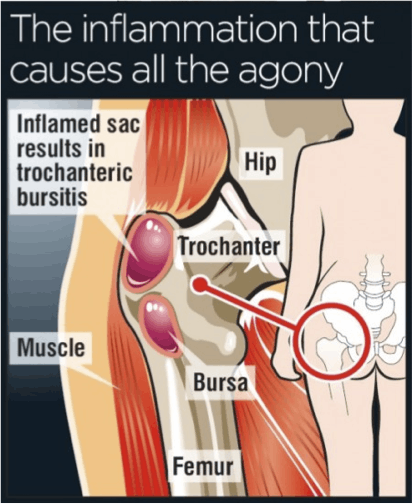By: Richard DeFalco, DPT, OCS, CSCS, CWcHP, Cert. DN
Do you suffer with hip pain? Do you have pain that is located on the outside of the hip and thigh, or in the buttock? Does the pain get worse with activities such as walking and stair negotiation? Do you have pain with lying on the affected side? If yes to these questions, then you may have trochanteric bursitis of the hip.
Trochanteric bursitis is when there is inflammation of the bursa of the hip. A bursa is a fluid-filled sac that is situated in areas where friction might occur, such as between tendon and bone. Bursa act as a buffer between opposing surfaces, such as bone and tendon. When the bursa becomes inflamed and irritated it causes pain in the hip. This pain is reflected in the manner mentioned above, pain on the outside of the hip that is increased with activity.
Causes of bursitis can be traumatic, such as a fall on the side of the hip, or bumping the hip into an object. It can also be caused by repetitive overuse such as running, cycling, or work related tasks. There may be structural issues, such as a leg length discrepancy or spinal misalignment such as scoliosis. Though these are not the only causes of bursitis, they are some of the more common. It is a common condition in women, due to anatomical predispositions, as well as in elderly individuals. Any condition that may cause abnormal pressures along the outside of the hip has the potential to lead to trochanteric bursitis.

Depending on the length and severity of the symptoms, there are different options for treatment. The goals of treatment are to reduce the inflammation/pain and restore normal mobility. Conservative treatment may include non-steroidal inflammatory medications, corticosteroid injections, and physical therapy. When all else has failed, surgery may be indicated, though research has shown that conservative treatments are quite effective.
The goal of physical therapy would be one that focuses on identifying the causative factors of the condition, and alleviating the pressures on the bursa. During your examination by one of our board certified orthopedic physical therapists, we will identify areas of dysfunction. These areas may be muscle weakness, soft tissue tightness, and poor movement patterns. A plan of care would be established to address these areas through prescriptive exercise, manual (hands-on) therapy, and modalities (ultrasound, electrical stimulation). The goal with any physical therapy regiment is to eliminate the problem and educate an individual on strategies to keep it that way.
One of the newest procedures that we have incorporated with great success is dry needling. The name sounds worse than the actual procedure! Dry needling is a process by which fine gauge solid filament needles are inserted into the symptomatic dysfunctional area to create tiny lesions (micro trauma) in the underlying soft tissue. These lesions stimulate the body's natural response of healing by way of secretion of proteins and the blood factors responsible for tissue remodeling to the affected areas, as well as stimulation of the central nervous system to create an anti-inflammatory reaction. In other words, the micro trauma that is caused in the tissue creates an environment that allows the tissue to remodel and repair itself. Because the needles are of an extremely fine gauge, the procedure has minimal to no pain associated with it.
A thorough history and physical examination by a board certified orthopedic physical therapist can determine if you would be a candidate for physical therapy to address your hip pain. At Professional Rehabilitation Services we pride ourselves in distinction and providing a higher level of care, and one of our Board Certified Orthopedic Physical Therapists will pursue an individualized treatment approach to your needs. Less than 5% of physical therapists in South Carolina are board certified in orthopedics. So if you or someone you know is having hip pain or another musculoskeletal problem and would like to know more about dry needling or other physical therapy options, seek the consultation of a physical therapist at one of our three locations or see your physician for a referral to one of our facilities. Physical therapy is a regularly covered service by most health insurance plans. Free 15 minute consultations are a great way to identify if you are a candidate for treatment!
At Professional Rehabilitation Services, we treat a wide variety of musculoskeletal and neurological conditions using the latest in evidence based therapies provided by highly credentialed physical therapists. For further information on this or other related topics you can contact Richard DeFalco, DPT, OCS, CSCS, CWcHP, Cert. DN at Professional Rehabilitation Services (Myrtle Beach) (843) 839-1300, Brian P. Kinmartin PT, DPT, MTC, OCS, STC, CWcHP, Cert. DN (Pawleys Island) (843) 235-0200, or Richard A. Owens, PT, MS, OCS, Cert. SHT, CWcHP, Cert DN (Surfside) (843) 831-0163, or visit our website at www.prsrehabservices.com where you can learn more about the company and even download a referral form for your physician to fill out. You can also call and schedule a free 15 minute consultation!
